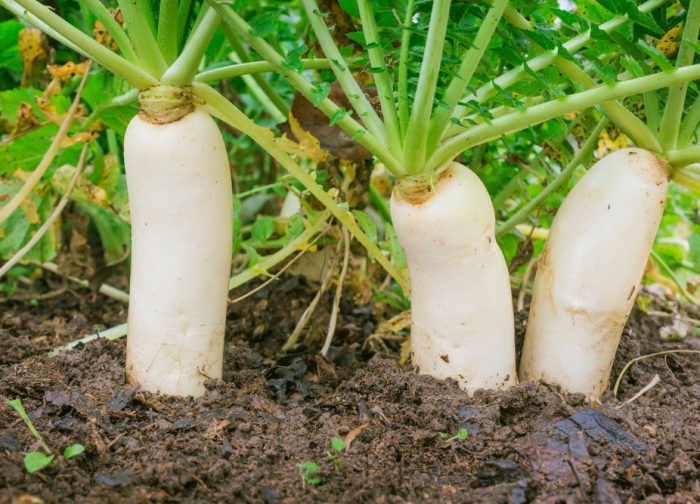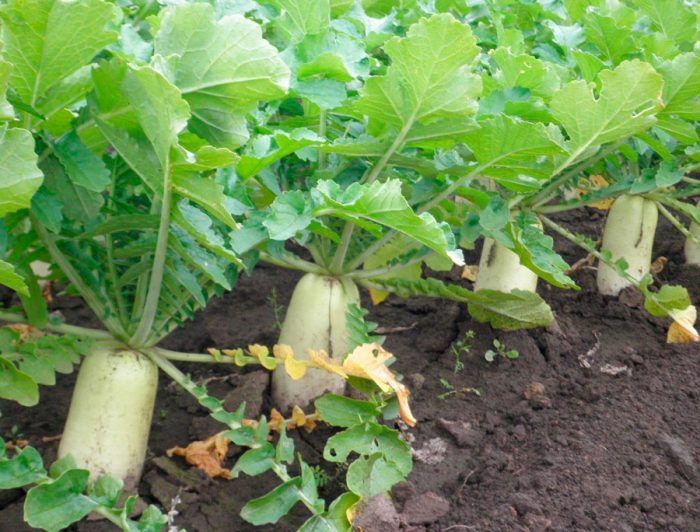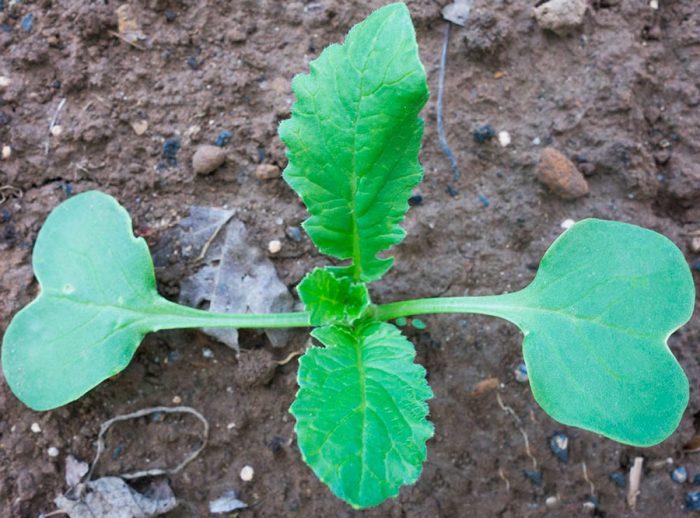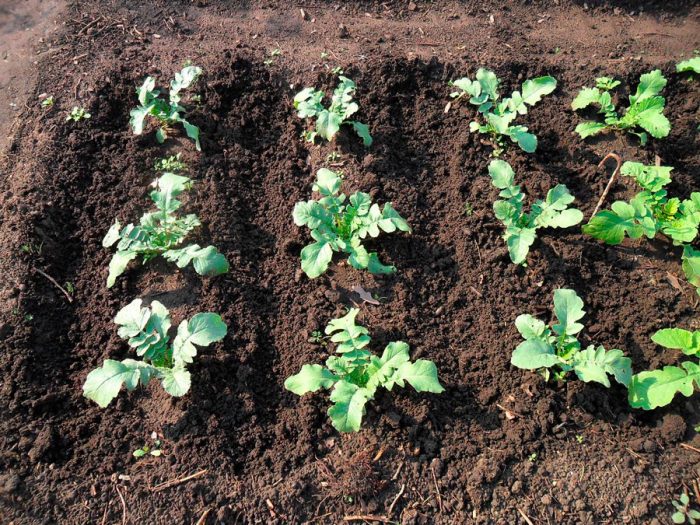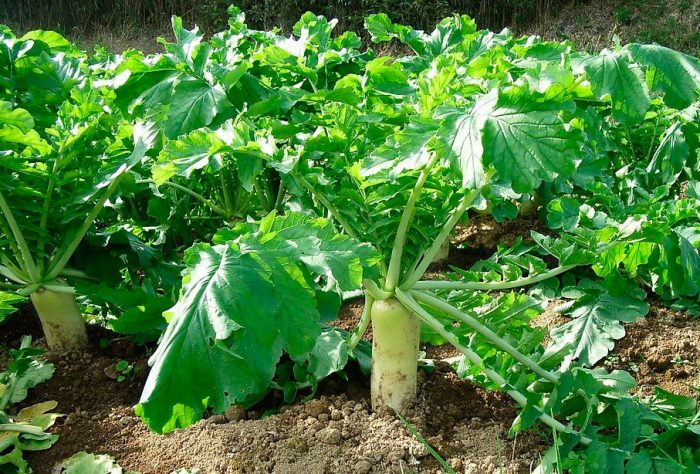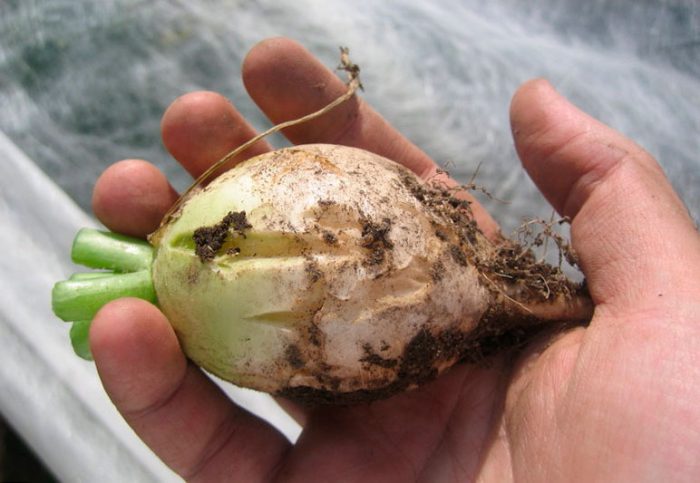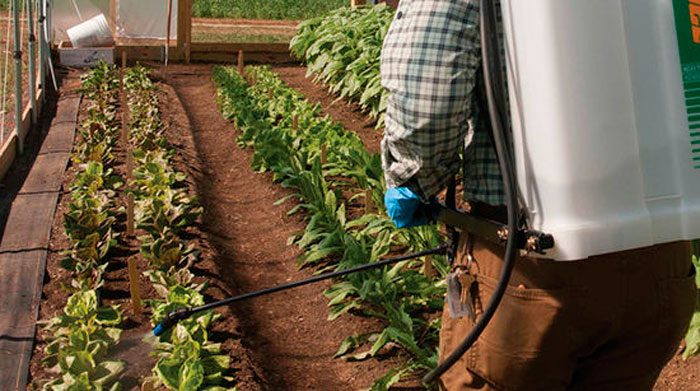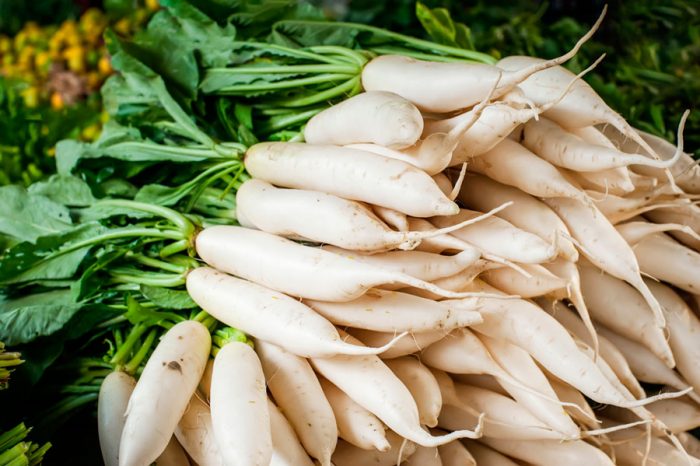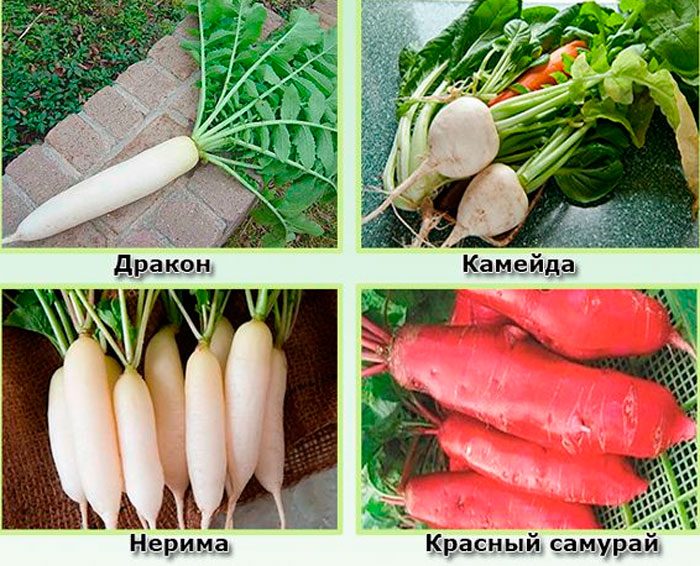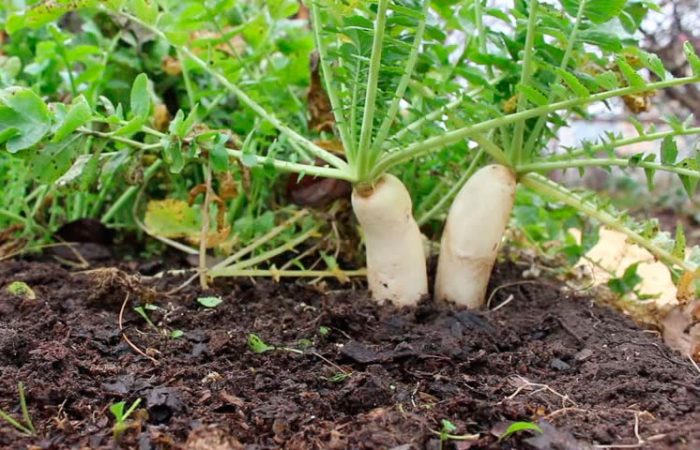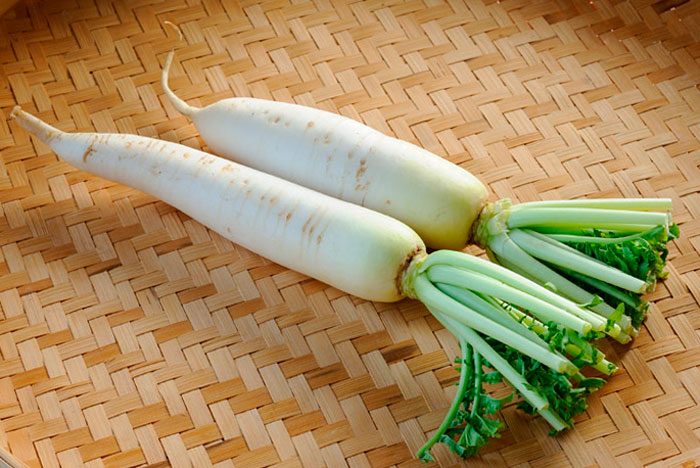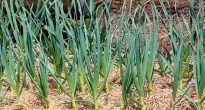Vegetable culture daikon, also called Chinese radish, or Japanese radish, or Japanese daikon, is a root vegetable that is a member of the Cruciferous family and a subspecies of sowing radish. This plant differs from radish and radish in that it does not contain mustard oils, and its aroma is relatively moderate. This variety was bred by Japanese breeders in ancient times, and it was obtained from the forehead plant, belonging to the Asian group of radish varieties, which occurs naturally in China. Daikon is translated from Japanese as "big root". In Japanese cuisine, this radish is one of the most important ingredients; it is used for making soups, salads and side dishes in boiled, pickled, fresh and stewed forms. In China, this vegetable is prepared with shiitake mushrooms, while Burmese and Koreans prefer salty daikon. In Eastern Europe, this root vegetable is most often called "white radish" or "white radish"; salads with sour cream, butter or cream are prepared from it.
Content
Features of daikon radish
Daikon can be an annual or a biennial. Over time, the plant should form a rosette, which consists of 12–40 highly dissected leaf plates. He also grows a root vegetable, which is larger than a radish, it weighs 0.6-4 kilograms, but sometimes root vegetables weighing about 20 kilograms are found. Such fruits do not have the pungency inherent in radishes, and their pulp is also more tender and juicy. This radish has good keeping quality and is rather successfully grown in mid-latitudes. The growing season lasts 40-200 days, and it directly depends on the variety. This plant is considered a relative of radishes, cabbage, turnips and other not-so-known representatives of the Cruciferous family. Every year this culture is gaining more and more popularity among gardeners, because the daikon is high-yielding and unpretentious.
Growing daikon from seeds
Sowing
Through seedlings, as a rule, those varieties of daikon are grown that have short oval or rounded fruits. The fact is that varieties with long roots reacts extremely negatively to picking and transplanting into open ground.Seeds are sown from the second half of March to the first days of April. Seeds need pre-sowing preparation. To do this, they are immersed in hot water (50 degrees) for a third of an hour, then immediately cooled in very cold water, and then put away on the refrigerator shelf for vegetables for 24 hours. It is recommended to sow seeds for seedlings in 2 or 3 pieces in peat-humus pots or in peat tablets. Planting daikon seedlings directly with these pots or tablets. If you decide to sow seeds in a container or box, then you should choose a container that is at least 10 centimeters deep, because this plant has a rather long root. Sowing is carried out in a moist, light, loose substrate, while the seeds need to be buried by 20 mm. The container on top should be covered with glass or film, and then it is transferred to a warm place.
Seedling care
If the growing conditions are favorable, the first seedlings will appear after 5 days, after which the film will need to be removed. It is quite simple to care for the seedlings, it should be watered in a timely manner, and also regularly loosen the surface of the substrate. After the first pair of true leaf plates is formed in the plants, it will be necessary to thin the seedlings, for this you need to remove the weak and sluggish seedlings, as they will interfere with the growth and development of stronger plants. When the seedlings are thinned out, they will need feeding, for this they use a solution of mineral fertilizer in a weak concentration. Daikon seedlings do not need too long daylight hours, since they need to grow root crops. If the daylight hours are excessively long, the plants may bloom, and the gardener will be left without a crop. Seedlings that will be transplanted into a greenhouse are recommended to be grown on a glazed loggia. If the daikon radish is planted in open soil, then half a month before planting, you need to start hardening it. To do this, the seedlings are transferred to fresh air every day, the duration of this procedure must be increased gradually and this is done until the plants can be outside around the clock.
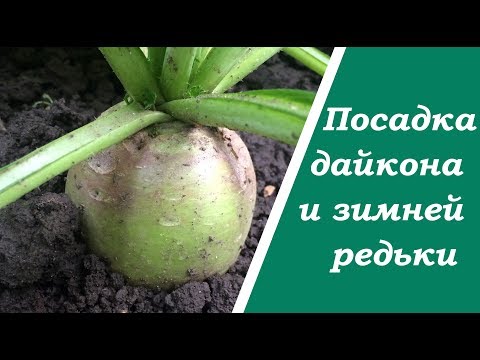

Watch this video on YouTube
Planting daikon in open ground
When to plant
It is recommended to plant daikon seedlings in open soil after the plants have formed 2 pairs of true leaf plates. The climatic features of your region, as well as the length of daylight hours, have a strong influence on the timing of planting seedlings in open ground, it should be no longer than 12-15 hours during the growth and development of the fetus. the bushes will go into the arrow. When the daikon is planted in open soil, the air temperature should not be lower than 10 degrees. To grow this crop, you should choose the most illuminated area.
Suitable soil
This plant is undemanding to the composition of the soil, however, it has been noticed that it grows better on neutral and loose sandy loam or loamy soils, while the groundwater should lie deep enough. However, there are also varieties that grow well on heavy clays. Sour soil can be corrected by adding lime to it. Soil with a pH of 6.0-8.0 is best suited for growing this crop.
The site for the daikon should be prepared in the autumn. So, the soil will need to be dug to the depth of the bayonet of the shovel, while 20 grams of ammonium sulfate and potassium sulfate, from 1 to 2 kilograms of humus or compost and 40 grams of superphosphate per 1 square meter of plot should be added to it. If lime needs to be added to the soil, then they do it half a month before fertilizing it. It is recommended to apply organic fertilizers under the previous crop, and not immediately before growing the daikon.The best predecessors of this plant are cucumbers, beets, potatoes, tomatoes and carrots. It is not recommended to grow such a radish in areas where representatives of the Cruciferous family (turnip, turnip, cabbage and radish) grew before.
Landing rules
Seedlings are planted in open soil according to the scheme of 30x60 centimeters, while the row spacing should be 0.6 m, and the distance between the bushes in a row is not less than 0.3 m. The planting is carried out in moist soil. When the plants are planted, the soil is trampled down a little, after which its surface is covered with a layer of mulch (peat). If there is a threat of recurrent spring frosts, then the first days after planting, it is recommended to cover the plants at night with any covering material, for example, plastic wrap.
Planting daikon before winter
You can resort to podzimny planting daikon. Its advantage is that plots are suitable for sowing after harvesting the following early crops: lettuce, dill or onions. In addition, at this time, there is a decrease in daylight hours, and therefore the risk that the bushes will begin to bloom instead of growing the root crop is significantly reduced. However, when sowing this crop in the fall, one should take into account the high probability that the fruits will not have time to reach their maximum size. Before proceeding with sowing, seed material must be subjected to pre-sowing preparation. You also need to prepare the soil on the site. Experts would hardly call this sowing podwinny, because it is carried out in the last days of July or the first days of August. However, in the southern regions, sowing seeds can be done in September.
Sowing is carried out in moistened soil, while 2 or 3 seeds should be placed in one hole. The distance between the holes should be at least 0.3 m, while the distance between the rows should be about 0.6 m. Seeds should be embedded in the soil to a depth of 15–20 mm. When sowing is done, the surface of the bed must be covered with a layer of mulch (peat). After the seedlings appear, it is necessary to thin them out, while in each hole there should be one most developed plant. It should be noted that the extra seedlings should not be pulled out, but plucked out, which will avoid damage to the fruit of the plant remaining in the hole.
Daikon care
Growing a daikon in your garden is relatively easy. So, this plant should be watered in a timely manner, loosened the surface of the garden, remove weeds, feed (when grown in poor soil), and also protect from harmful insects and diseases. In addition, the bushes need hilling, because over time, the fruit begins to peek out of the soil (in some cases, by 1/3 of its length).
How to water
To harvest a rich daikon crop, it needs to be watered systematically, while using enough water. The soil in the garden bed should be slightly damp throughout the growing season. The first watering is carried out after the seedlings appear. With an insufficient amount of moisture, there is a high probability that the bushes will go into the arrow, and in the formed fruits the pulp will become tough, and it will also have an unpleasant aroma and a bitter taste. It is necessary to water the garden regularly, otherwise cracks will appear on the root crops, and this will also have an extremely negative effect on their keeping quality. It is recommended to water the bushes on average once every 5 days. In a dry season, more frequent watering will be needed, and in a rainy season, you will have to water less often.
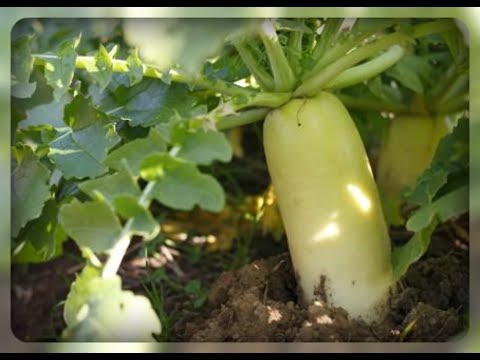

Watch this video on YouTube
Daikon pests and diseases
If the daikon is improperly looked after or the agrotechnical rules are violated, then the plant's resistance to diseases and pests decreases. It is affected by the same diseases as the rest of the Cruciferous family.
Mucous bacteriosis begins to develop if there is frequent stagnation of moisture in the soil.The first signs of this disease begin to appear, as a rule, in the second half of the growing season. As the disease progresses, the root crop becomes softened and turns dark. In some cases, even when laying vegetables in storage, it is possible to detect signs of disease on them, so, on the surface of root crops, it will be possible to see foci of wet rot.
This culture is also susceptible to diseases such as: black leg, mosaic, keela, vascular bacteriosis and felt disease. Prevention of viral and fungal diseases:
- adhere to the rules of agricultural technology and crop rotation of this crop;
- for sowing, use seeds of varieties that are resistant to fungal diseases;
- be sure to prepare seeds before sowing;
- remove weeds from the garden in time, as well as fight against harmful insects, which are the main carriers of incurable diseases;
- be sure to disinfect the storage;
- after harvesting, all plant residues that need to be burned must be removed from the site.
The cruciferous flea is the most dangerous of all pests for young bushes. On such a plant, the garden scoop, sprout and spring cabbage flies, rapeseed bugs and flower beetles, slugs, cabbage bugs, aphids and moths can still settle.
Daikon processing
In order to prevent the plant from damaging fungal diseases, it is imperative to take all preventive measures. But if the bush is still sick, then you will need to treat the entire bed with a solution of the biological product Planriz or Binoram, and you must follow the instructions attached to the drug. It is impossible to cure the mosaic, in this regard, the diseased bushes must be removed from the soil and destroyed as soon as possible, while the hole should be shed with a very strong solution of manganese potassium.
To prevent the cabbage flea from settling on daikon bushes, as soon as the seedlings are planted in open soil, the surface of the garden bed must be covered with coarse wood ash. As soon as the seedlings appear or the seedlings are planted on the garden bed, the soil surface should be sprinkled with fine wood ash. If other pests have settled on the bushes, then they should be sprayed with an infusion of red hot pepper. To prepare it, you need to combine 1 liter of hot water with five pods of red hot pepper. The infusion will be ready in 12 hours, after which it must be filtered and combined with 1 bucket of water. In the event that after one spraying with infusion, pests remain on the bushes, after 3-4 days they should be treated again. To destroy the larvae, the plant must be watered with a weak solution of manganese potassium. To scare off flies, marigolds must be sown around the perimeter of the beds with this crop. To prevent slugs from entering the garden, a groove should be dug around it, which must be filled with wood ash.
Cleaning and storing daikon
It is necessary to start harvesting the daikon 40–70 days after sowing (depending on the variety). If the daikon radish was sown in the ground in the fall, then the harvest will have to be harvested in October before the persistent cold begins. Roots should not be allowed to remain in the soil for a very long time, as the bushes may begin to bloom or the fruits will lose their taste. Harvesting should be done on a sunny, dry day. If the soil is light and loose, then the bushes can be pulled out with your hands, holding the tops. From heavy soil, the fruits will need to be removed using a shovel or pitchfork. The fruits extracted from the soil are dried, spreading them along the bed, after which the remnants of the earth are removed from them and the tops are trimmed. For storage, the roots are removed to the cellar, where the air temperature should be 0-5 degrees, and they must be placed in boxes with sand so that they do not come into contact with each other. If favorable conditions are created, then the fruits of the daikon can lie until early January.
Daikon varieties
The daikon has many varieties that are classified based on the shape of the root and the depth of its immersion in the ground. For instance:
- Group of varieties Nerime... Smooth roots are spindle-shaped and white in color, their length varies from 0.4 to 0.7 m, and they reach 8-10 centimeters across. Their flesh is very juicy. The fruits are buried in the soil by 1/3 or ¼ of the length.
- Miyashige hybrids... They are very popular with the Japanese. The length of the cylindrical fruits is from 0.35 to 0.5 m, and in diameter they reach from 70 to 90 mm, while they are buried in the ground by 2/5 or ½ of the length.
- Shogoin group... It has a lower yield, but such varieties grow well in heavy clay soil. The shape of the root crops can be flat-rounded and round; they reach 15–20 centimeters across. They are immersed in the soil by ¼ or 1/5 of their length.
- Sirogari group... Here are collected early maturing varieties. The length of cylindrical fruits is from 0.25 to 0.3 m, and in diameter they reach from 6 to 7 centimeters. The fruits are buried in the ground by 2/3 or ¾ of the length. The duration of the growing season for such varieties is approximately 55 days.
- Minovase's group (Minovashi)... This relatively large group combines early maturing varieties that are resistant to heat and disease. The lower part of the fruit is elongated-conical, and the upper part is cylindrical. They reach 0.4–0.5 m in length, and 7–8 centimeters in diameter; fruits are immersed in the soil by ¾ of their length. Such varieties must be grown on light sandy loam soil. This article describes how to sow and grow daikon varieties of this group.
- Nineigo Group... It includes varieties in which the roots are completely immersed in the ground, their lower part is elongated-conical, and the upper part is cylindrical. The length of the fruits is from 0.4 to 0.6 m, and in diameter they reach 50-60 mm. Such varieties are resistant to frost and shooting, and it is recommended to grow them in light soil.
- Kameida Group... The varieties included in it have conical fruits that reach 12-15 centimeters in length, and their diameter is 10-50 mm, they are buried in the soil by 2/3 of the length. The taste of the fruit is spicy. In such varieties, foliage is also eaten. It is recommended to grow varieties of this group in areas with light soil.
Also, varieties are divided according to the growing season into early (spring), mid-ripening (summer) and late-ripening (autumn). Below, unusual varieties of daikon will be described, from which everyone can choose the one that is suitable specifically for his garden:
- Daikon Sasha... This early maturing medium-yielding variety is zoned for middle latitudes. The duration of the growing season is 35–45 days. Large white fruit is sunk into the soil for ½ part of its length. The crispy juicy flesh has a moderately pungent taste and snow-white color; at the surface it is pale green. It is quite simple to grow such a variety, but it should be borne in mind that its fruits can have different sizes.
- Pink glitter misato... This is a variety of Japanese selection. A slight pink glow can be seen on the cut of the fruit. If this variety is sown in springtime, then there is a high probability that it will go to the arrow. And when planted in autumn, its roots will be small. It is recommended to grow this variety in the southern regions, but it is not very suitable for middle latitudes.
- Dubinushka... This mid-season variety is resistant to mucous bacteriosis. If the growing conditions are optimal, then white fruits will reach 0.6 m in length, and they will weigh from 3 to 4 kilograms. The white pulp is sweet and juicy.
- The Dragon... This mid-season variety is distinguished by its yield. Smooth fruits have a conical shape and white color, they reach 0.3–0.6 m in length and 60–80 mm in diameter. They weigh about 1 kilogram. Juicy and very tender pulp is quite dense, it has a sweetish taste, while its taste is high.
- Flamingo... This mid-season hybrid is distinguished by its resistance to flowering and productivity. The smooth fruit has an average size and shape of an icicle, it is colored violet-pink-white, while its flesh is pink. The fruit weighs from 0.6 to 0.8 kg, it is immersed in the ground for 2/3 of the length.
- Tsukushi spring cross... Such an early ripening hybrid is distinguished by its yield and resistance to shooting. The smooth white fruits are cylindrical and weigh about 0.8 kg. Juicy and tender flesh is colored white. The fruit can be pulled out of the ground without effort.
Also in the middle latitudes, you can grow varieties such as: Caesar, Favorite 9908099, Japanese White Long, Tokinashi, Big Bull, Elephant Fang, Aokabi-daikon, Sakurajima, etc.
Daikon properties: harm and benefit
Useful properties of daikon
Daikon is a low-calorie product that contains a very large amount of vitamin C. Root vegetables also contain an enzyme that helps to improve the digestion of starches. In this regard, the fruits are recommended to be included in the diet for people who want to lose weight. They also include phytoncides, which improve the body's resistance to various infections. And the layers of potassium contained in them contributes to the fact that the body is freed from toxins, toxins, and also excess fluid. They also contain substances such as esterase, amylase and enzymes, which help to normalize metabolic processes in the body, and also improve the absorption of fats, carbohydrates and proteins. In addition, the fruits of this plant contain salts of magnesium, phosphorus and iron, fiber and pectins, a large amount of beta-carotene and B vitamins.
Daikon is recommended for use in the treatment of cardiovascular diseases and atherosclerosis. If it is eaten raw, then the person's appetite will improve, and his body will be cleared of excess cholesterol, and it also helps to eliminate radiation. It is recommended to drink 1 tbsp immediately before meals. the juice of such a plant, since it contains sulfur, which has a positive effect on the functioning of the gallbladder and liver. In case of respiratory diseases (asthma, colds, bronchitis, chronic cough and flu), experts also advise using daikon juice, since it has an antimicrobial and antiviral effect. Get rid of a hangover will help 0.2-0.3 kg of grated root vegetables. To remove freckles, heal purulent wounds, and make hair stronger, this juice is recommended to be used externally in the form of lotions and compresses.
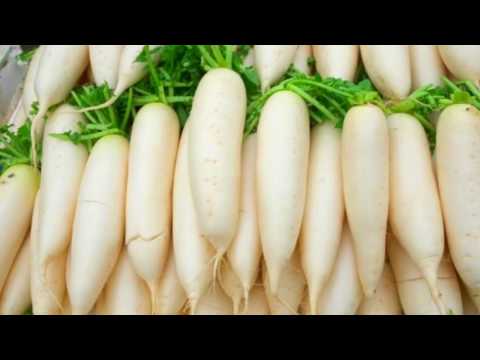

Watch this video on YouTube
Contraindications
This root vegetable is not recommended for people with diseases of the gastrointestinal tract, as it includes a large amount of fiber, and in the process of digestion, it can cause the development of indigestion and flatulence. Also, it should not be eaten in the presence of ulcers, gout or hyperacid gastritis, as well as in case of impaired renal function. Those over fifty are advised to consult a specialist before including daikon in their diet.

